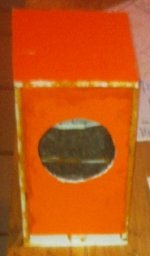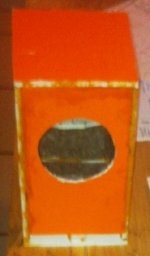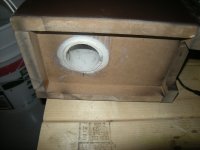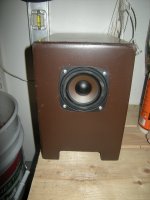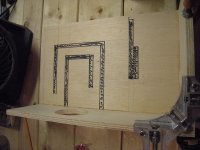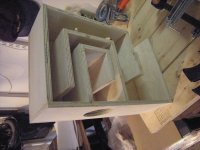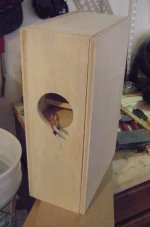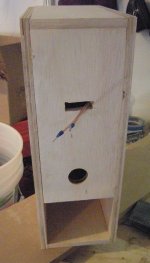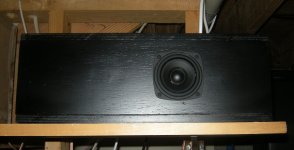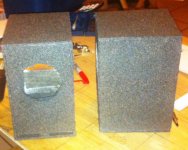I'm very new to the idea of building speakers, but I'm buying MDF and Baltic Birch ply for a 16" band saw I'm building and I'll have left over stuff. I thought I'd take a crack at speakers.
I'm ordering some Tang Band W3-881si speakers. I want to design something like the Gotham & Son Mercer speakers for my TV or uFonken type for my desktop computer. I have the FF85K uFonken ov9 plans in front of me and they are as detailed as I've seen about what is inside a speaker. I have no idea what's inside a Mercer speaker, but they look like the same Tang Band speakers.
I thought I might try mounting them in some wooden ammo boxes just to see what would happen. 😉
I have no idea on what design to match with these full range drivers. I found these calculators which seem like they would be helpful if I knew anything about the terms used:
Enclosure Calculators | DB DYNAMIX AUDIO
What does this noob need to know? Cheers, Seth
I'm ordering some Tang Band W3-881si speakers. I want to design something like the Gotham & Son Mercer speakers for my TV or uFonken type for my desktop computer. I have the FF85K uFonken ov9 plans in front of me and they are as detailed as I've seen about what is inside a speaker. I have no idea what's inside a Mercer speaker, but they look like the same Tang Band speakers.
I thought I might try mounting them in some wooden ammo boxes just to see what would happen. 😉
I have no idea on what design to match with these full range drivers. I found these calculators which seem like they would be helpful if I knew anything about the terms used:
Enclosure Calculators | DB DYNAMIX AUDIO
What does this noob need to know? Cheers, Seth
I just built a pair of uFonken with foam core and ordered a pair of W3-881SI to see how they sound. I'm sure there are other threads here that discuss the use of the W3-881SI in the uFonken, and in other enclosures.
I just built a pair of uFonken with foam core and ordered a pair of W3-881SI to see how they sound. I'm sure there are other threads here that discuss the use of the W3-881SI in the uFonken, and in other enclosures.
Pictures please🙂
I wonder what they would sound like in a couple of wooden ammo boxes. 😉 I could use shells for feet. Not really into shooting here, but we have a couple of ammo boxes that we use for magazines and mail.
Try it - fill with pillow stuffing. They should sound fine. Lots of boomboxes using this idea. If you want bass reflex use winisd and calculate vent for deeper bass.
Pictures please🙂
Not the prettiest, as it is my first foam core build. It is 3/16" thk. foam core. I have some old X-Acto "imitation" knives, so the cuts were not the best. Later I found out that 3/16" foam core easily cuts with scissors, so next one I might use a good pair of really sharp scissors I have. I also had a cheap-o compass to mark the circle for the holes, my good one is nowhere to be found. So, the hole for the driver is not the roundest, but within specs. I learned a lot, hadn't use foam core since my college days, there are some small gaps which I will correct with some kind of filler (wood, spackle, caulk, or silicone). They will be primed and painted, so they don't look so bad. The table is actually the 12 mm x 2' x 4' baboon plywood panel from which the final enclosures will be built. You can also see the felt used to line the inside of the enclosure. There is no picture of the other one, as I'm in the middle of cutting and gluing it.
Attachments
Last edited:
Guangui,
Thanks. A sharp razor is the best for clean cuts. Scissors crush the edge. Cut in several strokes with the first defining path and go deeper each time. Very clean that way. How does it sound?
Thanks. A sharp razor is the best for clean cuts. Scissors crush the edge. Cut in several strokes with the first defining path and go deeper each time. Very clean that way. How does it sound?
Guangui,
Thanks. A sharp razor is the best for clean cuts. Scissors crush the edge. Cut in several strokes with the first defining path and go deeper each time. Very clean that way. How does it sound?
Tried the scissors, and yes they crush the edges. The X-Acto knives I have cut well, but in some areas they kind of rip the foam. I have plenty of razors, should have thought about the obvious before.
I wonder what they would sound like in a couple of wooden ammo boxes.
look here: http://www.diyaudio.com/forums/full-range/228561-bookshelf-build-tb-w3-881si-nice.html
excellent sound I listen to it almost daily.
gychang
I have built two different speakers with the TANG Band 3" full range drivers
My favorite is the Del Sol at the following URL
DelSol - Aura NS3-194-8E - Inexpensive DIY Fullrange Bookshelf Speaker
The site has the complete plans and my version the sounds great to my ears with a surprising level of bass and great midrange. There is a lot of build experience with this speaker design on the internet. My cabinet did not have any damping material on the back.
I also built a folded horn version. Which was a challenge for my limited wood working skill. I would get some advice on stuffing the cabinet. I only stuffed the main speaker chamber, but I did not really know what I am doing and did not test the speaker before final assembly
Torvi-R08 �݌v�}
This site is in Japanese, but my web browser did an pretty good translation. There detailed drawings in mm (unfortunately). Some dimension adjustment is needed since the plans are for 9mm plywood.
Sorry no measurements on either finished speaker.
Good Luck!
My favorite is the Del Sol at the following URL
DelSol - Aura NS3-194-8E - Inexpensive DIY Fullrange Bookshelf Speaker
The site has the complete plans and my version the sounds great to my ears with a surprising level of bass and great midrange. There is a lot of build experience with this speaker design on the internet. My cabinet did not have any damping material on the back.
I also built a folded horn version. Which was a challenge for my limited wood working skill. I would get some advice on stuffing the cabinet. I only stuffed the main speaker chamber, but I did not really know what I am doing and did not test the speaker before final assembly
Torvi-R08 �݌v�}
This site is in Japanese, but my web browser did an pretty good translation. There detailed drawings in mm (unfortunately). Some dimension adjustment is needed since the plans are for 9mm plywood.
Sorry no measurements on either finished speaker.
Good Luck!
Attachments
Very interesting responses since I last checked. Thanks for the practical feedback. I especially like the examples gychange and bigberts. Great stuff.
Bigberts, what is the purpose for all the maze of tunnels in that one you posted? I've seen people doing this, but I have not heard about the theory behind it. From a simplicity stand point the DelSols look very practical.
I'm still sorting out how people go about deciding what to put into what space and why. I need to read some books on this stuff. It seems like there is a lot of guess and check--plug and try--without much calculation. It also seems that many people just look for a speaker that someone else has already done the experimenting on and then they just try and duplicate results. (Like there is only one box that works with each driver, so why reinvent the wheel?)
Anyhow, very interesting to ponder.
Bigberts, what is the purpose for all the maze of tunnels in that one you posted? I've seen people doing this, but I have not heard about the theory behind it. From a simplicity stand point the DelSols look very practical.
I'm still sorting out how people go about deciding what to put into what space and why. I need to read some books on this stuff. It seems like there is a lot of guess and check--plug and try--without much calculation. It also seems that many people just look for a speaker that someone else has already done the experimenting on and then they just try and duplicate results. (Like there is only one box that works with each driver, so why reinvent the wheel?)
Anyhow, very interesting to ponder.
Guangui,
Thanks. A sharp razor is the best for clean cuts. Scissors crush the edge. Cut in several strokes with the first defining path and go deeper each time. Very clean that way. How does it sound?
Here is the semi-finished enclosures, waiting on the W3-881SI drivers, as I just ordered them today, also ordered banana terminals for the back. In the order there is a pair of W3-1364SA that were intended for this enclosure, but if the 881's do the trick ($9.90 vs. $37.89) they will stay in the enclosure, and the 1364's will be used in another project, or in a wood uFonken cabinet. Rookie mistake, I forgot to do the holes for the terminals, but nothing that can't be fixed easily.
Attachments
Very interesting responses since I last checked. Thanks for the practical feedback. I especially like the examples gychange and bigberts. Great stuff.
Bigberts, what is the purpose for all the maze of tunnels in that one you posted? I've seen people doing this, but I have not heard about the theory behind it. From a simplicity stand point the DelSols look very practical.
I'm still sorting out how people go about deciding what to put into what space and why. I need to read some books on this stuff. It seems like there is a lot of guess and check--plug and try--without much calculation. It also seems that many people just look for a speaker that someone else has already done the experimenting on and then they just try and duplicate results. (Like there is only one box that works with each driver, so why reinvent the wheel?)
Anyhow, very interesting to ponder.
What you see with the maze of tunnels is referred to as a back-loaded, folded horn. They are complicated to build, yes, but even more complicated to design properly.
Most (good-sounding) speaker cabinets are carefully designed, with quite complex mathematical calculations that can be assisted greatly by various computer software. The reason why many of us just use other designs is because most of us do not have the knowledge/experience and access to software and/or design tools to do it right. Or, we have access to all the knowledge and tools but we are just plain too busy or lazy to learn.
Two types of cabinets are relatively simple; 1) sealed and 2) simple bass-reflex.
Some simple free design software can be used to design half-decent sealed or bass-reflex cabinets for almost any driver. One of these programs is called "WinISP". You can download it and try it. It is simply a matter of creating a new entry in the driver database for your driver and then entering the T/S parameters. Then you just start a new project, choose sealed or ported (bass reflex) and then start playing around (or just accept the default box that WinISP comes up with).
Back-loaded horns, mass-loaded transmission lines, TQWTs, etc. etc. are much more complicated and the learning curve gets very steep, so at least in the beginning it is likely best to use proven designs by the experts. You will soon learn who those people are around here. I am not one of them, but I have been around long enough to know what I am capable of, and what I need to leave to others.
Good luck to you. This is an immensely satisfying hobby you have chosen to explore.
By the way, I have done my own "accidental transmission line" for the W3-881SI. It started out as a simple bass reflex in WinISP, but it performs far better than a simple BR due to its dimensions. I call it the nanoTower. You'll find the thread easy enough with the search function, if you are interested.
Last edited:
I think Cogitech means WinISD (not ISP) bass reflex design software. 🙂 If you are adventurous and want to try playing with horn designs, a very good package called Hornresp is very helpful. Both are free. If you want to learn more about how to design horns and TL's a great place to do some reading is Martin J King's website called Quarterwave http://www.quarter-wave.com/. MJK's software runs on Mathcad and is one of the most respected simulations for how accurate it models many horns and transmission lines. It costs $25.
Good Luck.
Good Luck.
Last edited:
Yes, thanks for the correction, xrk. I had a total brain fart there.
Wallygoots, if you are anything like me, Hornresp and MJK's worksheets will be entertaining at most but will ultimately leave you completely confused.
I do, however, wish the best of luck if you go for it.
Wallygoots, if you are anything like me, Hornresp and MJK's worksheets will be entertaining at most but will ultimately leave you completely confused.
I do, however, wish the best of luck if you go for it.
Not the prettiest,..
did u use the demensions of file I attached? (uFonkenWK-1v0-plan-130312.pdf)
gychang
Attachments
Thanks for all the good information guys. I'm recovering from surgery, so figuring out some of the specifics of future projects is a good way to keep my brain from eating itself. I've spent the last hour or so trying to figure out WinISD. I think entered the info correctly, but I don't yet know how to read the graphs in order to optimize anything.
The curious things about back loaded folded horns to my thinking is that it seems to indicate that air volume, venting, and materials seem to take a back seat to path in those designs. What does a certain path do? Very curious. I can see I'll probably be starting out with simple closed or vented designs like the uFonken and not trying a back loaded folded anything very soon.
cogitech, do you find WinISD to be less confusing then other software design programs? I'm not understanding much about the graphs and calculations yet, but that doesn't frustrate me too much. This is a new thing for me. Really, it more of a break from some of my other projects--a shop made 16" bandsaw and a Hall Taylor rocking chair. 🙂
The curious things about back loaded folded horns to my thinking is that it seems to indicate that air volume, venting, and materials seem to take a back seat to path in those designs. What does a certain path do? Very curious. I can see I'll probably be starting out with simple closed or vented designs like the uFonken and not trying a back loaded folded anything very soon.
cogitech, do you find WinISD to be less confusing then other software design programs? I'm not understanding much about the graphs and calculations yet, but that doesn't frustrate me too much. This is a new thing for me. Really, it more of a break from some of my other projects--a shop made 16" bandsaw and a Hall Taylor rocking chair. 🙂
did u use the demensions of file I attached? (uFonkenWK-1v0-plan-130312.pdf)
gychang
Yep, built as per the drawing. And lined as per recommendation of other DIY'ers including Planet 10.
Thanks for all the good information guys. I'm recovering from surgery, so figuring out some of the specifics of future projects is a good way to keep my brain from eating itself. I've spent the last hour or so trying to figure out WinISD. I think entered the info correctly, but I don't yet know how to read the graphs in order to optimize anything.
The curious things about back loaded folded horns to my thinking is that it seems to indicate that air volume, venting, and materials seem to take a back seat to path in those designs. What does a certain path do? Very curious. I can see I'll probably be starting out with simple closed or vented designs like the uFonken and not trying a back loaded folded anything very soon.
The only reason the folded horns look like a maze is because they are folded, and the only reason why they are folded is to make a cabinet with reasonable dimensions. Unfold the horn and you would end up with a speaker cabinet that would be difficult to fit in a standard room! 🙂
cogitech, do you find WinISD to be less confusing then other software design programs? I'm not understanding much about the graphs and calculations yet, but that doesn't frustrate me too much. This is a new thing for me. Really, it more of a break from some of my other projects--a shop made 16" bandsaw and a Hall Taylor rocking chair. 🙂
I actually find WinISD to be fairly straightforward, but I didn't necessarily feel that way the first time I used it. There may be video tutorials on youtube, but I've never looked for any.
Basically, once you have your driver T/S parameters entered into the DB and start either a sealed or BR project, select the number of drivers, etc. then WinISD will automagically calculate a box for you. You can play with box volume and port tuning (only in BR, of course) and the graph will change accordingly. It is a simple frequency response graph which shows you the lower end of the frequency response graph (that is what the cabinet is affecting, after all).
By playing with the box vloume and port tuning, you can sometimes stretch the response out to something you think you would like better than what WinISD came up with. Try tuning it lower if you want more bass response, etc. There are always trade-offs. Ideally you have a flat response that tapers off in a nice smooth curve, for the "highest fidelity". Traditionally, one would try to avoid big dips or humps in the curve, as that will tend to result in unbalances low end frequency response. So, as you continue to tweak the volume and port tuning, you can come up with a compromise that you are comfortable with. Aggressively low tuning with some -3 to +3 dB humps or dips? Perfectly smooth curve, but with ultimately less low end? It's up to you.
Then you change the box dimensions to what you want, maintaining the volume you decided on while playing with the graph. Finally go to the port (vent) section and specify a suitable port diameter. The length will be calculated automatically for the tuning you chose earlier. Make sure the vent speed doesn't go too high or you will get vent noise ("chuffing"). If the vent speed is too high, increase port diameter (but be aware that the length will also increase quickly. Find a good balance.
The one thing to be aware of is that if you push the tuning really low on a driver that is not designed for it, you will reach the driver's maximum excursion (Xmax) very quickly. What this means is that you will need to be very careful with the volume control if you push a driver beyond its intended use.
Prime example is the nanoTowers. I have received plenty of criticism from the experts around here (and I am sure it is well deserved) about my design and how the little Tang Bands are not meant to do what I am doing with them. The thing is, I am typically pushing less than a watt through them and even when I do push them harder, they handle it without any perceivable issues. I got lucky with my design. I rolled the dice and it worked out. My next dice roll might not. That's half the fun.
Thanks cogitech,
Can you give me some feedback on WinSID. I think I'm understanding better because of your explanation, and I've been playing around.
Vol. 430
Htz. 53
Dimentions: W 5.5" x H 12" x D 11.75
Vents: 1 circular 1.5" vent 5.6" long.
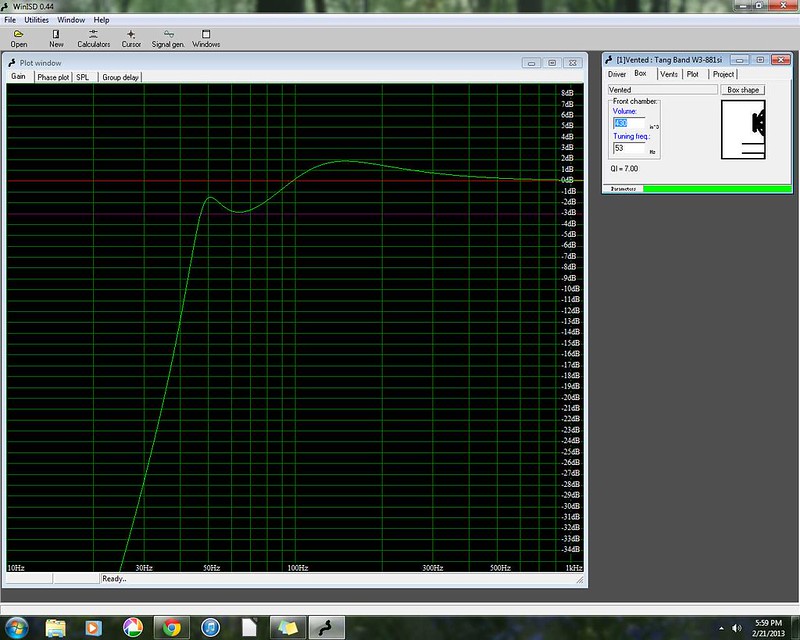
Can you give me some feedback on WinSID. I think I'm understanding better because of your explanation, and I've been playing around.
Vol. 430
Htz. 53
Dimentions: W 5.5" x H 12" x D 11.75
Vents: 1 circular 1.5" vent 5.6" long.

- Status
- Not open for further replies.
- Home
- Loudspeakers
- Full Range
- Designing Tang Band 881si Enclosures
